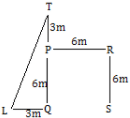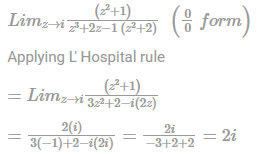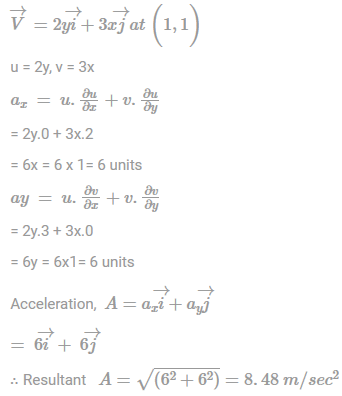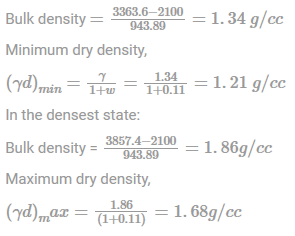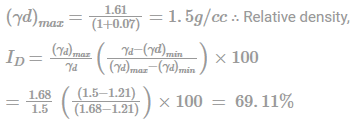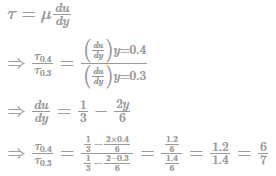Practice Test: Civil Engineering (CE)- 2 - Civil Engineering (CE) MCQ
30 Questions MCQ Test - Practice Test: Civil Engineering (CE)- 2
Which of the following states the meaning of the idiom ‘Into the bargain’?
Direction: Find the correct relationship between the given quantities-
Quantity I: Let E be the set of all integers with 6 in their unit place. The probability that a number chosen from the set {10, 11, 12, ........59} is a member of E is?
Quantity II: A boy speaks truth in 70% of cases while another boy speaks truth in 65% cases. The probability that they will contradict each other on stating the same fact is?
A square metallic sheet of an area of 1296 square cm is used for making the toys. For taking the metallic sheet from that square – four equal sized circular plates have been cut –off. If a fencing with the Silver thread is required to make the base of toys, how many rolls of the thread is required, if a roll contains 30 cm of the thread only?
In the following question, some part of the sentence may have errors. Find out which part of the sentence has an error and select the appropriate option. If a sentence is free from error, select ‘No Error’.
I suppose no place is more (1)/ better than (2)/ home on Christmas. (3)/ No error (4)
Direction: Read the pie chart given below and answer the following questions-
The pie chart given shows the population of India in the 7 states considering there are no other states apart from these.

Q. How much percent more is the population of UP than that of Odisha?
In a class test, A scored 51 marks. The test had 4 sections. In the second section, A scored 7 marks more than in the first section, and in the third section, A scored 7 marks more than in the second section. If A did not score at all in the fourth section, how much did A score in the second section?
Direction: Study the information carefully and answer the questions given below.
P is standing north of Q at a distance of 6m. R is standing toward east of P at a distance of 6m. R is to the north of S and the distance between them is 6m. P is facing north direction, R is facing east, S is facing North and Q is facing towards west direction. All of them walk straight for 3m.
Q. What is the distance between the final position of P and Q?
In the following question, a statement has been given followed by two arguments numbered I and II. Based on the argument, you have to decide which of the following arguments is strong and which is a weak argument.
Statement: Shiva trilogy written by Amish Tripathi is the best fiction book.
Arguments
I. Yes, None other fiction books have three parts.
II. No, the best fiction book is subjective and it always differs from person to person.
In the following question, some parts of the sentence may have errors. Find out which part of the sentence has an error and select the appropriate option. If a sentence is free from error, select ‘No Error’.
If this be overlooked, a wrong (1)/ impression may be derived as (2)/ to the most absolute amplitudes of the changes. (3)/ No error (4)
Direction: Following bar graphs show time taken by different pipes to fill that particular percentage of tank which is described in tabular data. For Ex- Pipe 1 fills the 10 % of the tank in 6 mins.
Now, read the following data and answer the question carefully:
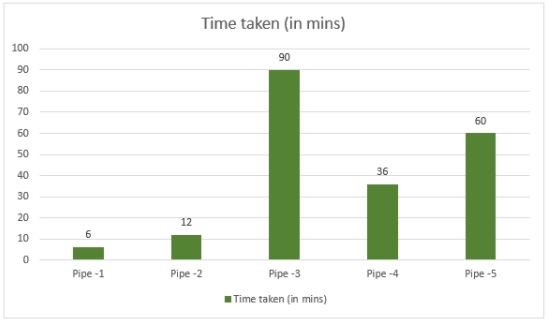

A Tank has three pipes; two of them are used to fil the tank while another one used to empty the tank namely: pipe 3, pipe 5 to fill the tank and a new third pipe for making the tank empty. When all three pipes are open, 7/18th part of the tank is filled in 1 hours. What is the ratio of the efficiency of Pipe-3: Pipe 5: all three pipes working together.
For a complex number z, find the value of 
The velocity potential for a two-dimensional flow is given by ϕ = x2-y2+3xy. The flow rate between the streamlines passing through points (1, 2) and (2, 3) is
A velocity field is given as ![]() where x and y are in metres. The acceleration(magnitude) of a fluid particle at (x, y) = (1, 1) is ___.
where x and y are in metres. The acceleration(magnitude) of a fluid particle at (x, y) = (1, 1) is ___.
The matrix A is 3 × 3 matrix, if the matrix is a singular matrix then which of the following statement is true;
Consider the following function.
F(x) = (1/3)x3 + (1/2)x2 - 6x + 1000
Find the value at which f has a relative minimum.
Over 1500 students appeared for the exam. The entrance exam has 100 multiple choice questions, each carrying 1 mark. Each question has 4 options. Due to negative marking, every incorrect choice gets –0.33 marks. Suppose 800 students choose all their answers randomly keeping uniform probability. The expected marks for 100 questions is
Given a vector field ![]() , the one integral ∫F.dl evaluated along a segment on the x-axis from x = 1 to x = 2 is
, the one integral ∫F.dl evaluated along a segment on the x-axis from x = 1 to x = 2 is
Match the following:
Group–I
P Rainfall intensity
Q Rainfall excess
R Rainfall averaging
S Mass curve
Group–II
1. Isohyets
2. Cumulative rainfall
3. Hyetograph
4. Direct runoff hydrograph
An L = beam is shown in the figure below and is subjected to a factored shear force of 200 kN.
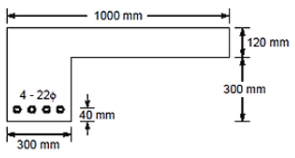
Design shear strength of concrete, τc, for M20 grade of concrete is as given below in the table
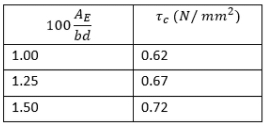
Use Fe415 steel
The design shear stress for vertical stirrups is ____ N/mm2.
A layer of a beam at a distance y from the neutral layer is considered. If the beam is subjected to simple bending, and the radius of neutral is constant. Which of the following is correct?
Which assumptions are incorrect in column theory?
The value of P that results in the collapse of the beam shown in the figure below and having plastic moment capacity of MP is

In order to determine the relative density of a sand sample, its natural moisture content and bulk density were determined in the field and were found to be 7% and 1.61 g/cc respectively. Sample of this soil was then commented in a Proctor’s mould of 943.89 cc capacity at the loosest and the densest states. The following data were obtained:
1) Weight of empty mould = 2100 g
2) Weight of mould + soil in the loosest state = 3363.6 g
3) Weight of mould + soil in the densest state = 3857.4 g
4) Moisture content of the sample used in tests = 11%
Q. The relative density of sand is ______%.
A city has a population of 10, 00,000. Average water consumption of the people is 270 lpcd, then the maximum hourly demand in MLD is
If the sensitivity of the bubble tube of a level is 30" of arc per division, then the distance of a point at which the combined curvature and refraction corrections become numerically equal to the error induced by dishevelment of one division of the level tube (in m) is
On a plate u = 1/3 y - y2/6, where u is in m/sec & y is in m & μ of fluid = 0.5 Ns/m2. Shear stress at 0.4 m above plate and 0.4 m above plate are in ratio
The data given below pertain to the design of a flexible pavement.
Initial traffic = 1350 cvpd
Traffic growth rate = 7% per annum
Design life = 15 years
Vehicle damage factor = 2.50
Distribution factor = 1.05
The design traffic in terms of Million standard axles (MSA) to be catered would be.
What will be the population equivalent for an industrial sewage daily disposal of 50,000 litres with suspended solid content of 220 mg/lit, considering the per capita contribution as 69 gm.
A centrifugal pump will start delivering the liquid only when
On an urban road, the free mean speed was measured as 70 kmph and the average spacing between the vehicles under jam condition as 7.0 m. The speed-flow -density equation is given by
U = Usf[1 − k/kj] and q = Uk
Where U = space-mean speed (kmph); Usf = free mean speed (kmph); k = density (veh/km); kj = jam density (veh/km); q = flow (veh/hr). The maximum flow (veh/hr) per lane for this condition is equal to



